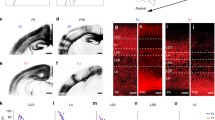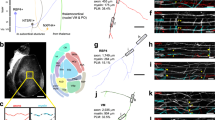Abstract
IT is now well known that some central nervous system axons can regenerate following axotomy1,2 or sprout in reaction to nearby denervation3. The cholinergic projection from the septal nuclei to the hippocampal formation has demonstrated the ability both to regenerate4,5 and sprout6,7. However, the possibility that axons in the mature mammalian brain can be induced to grow in other circumstances has not been investigated. We have examined the ability of the axons of the fimbria, the fibre bundle which interconnects the septal nuclei and the hippocampal formations, to grow in circumstances other than those used in classical regeneration and sprouting research. The fimbria is particularly suitable for the study of axonal growth in brain as its fibres run as an unbranched bundle, with one surface exposed to the lateral ventricle and thus free from surrounding neuropil. Consequently, it is readily accessible for experimental manipulation. We demonstrate here that fibres of the fimbria in the adult rat brain can be induced to grow in circumstances that neither sever them nor denervate regions to which they normally project.
This is a preview of subscription content, access via your institution
Access options
Subscribe to this journal
Receive 51 print issues and online access
$199.00 per year
only $3.90 per issue
Buy this article
- Purchase on Springer Link
- Instant access to full article PDF
Prices may be subject to local taxes which are calculated during checkout
Similar content being viewed by others
References
Guth, L. Expl Neurol. 48, 3–15 (1975).
Kerr, F. W. L. Expl Neurol. 48, 16–31 (1975).
Cotman, C. W. & Lynch, G. S. in Neuronal Recognition (ed. Barondes, S.) 69–108 (Plenum, New York, 1976).
Svendgaard, N.-A., Björklund, A. & Stenevi, U. Brain Res. 102, 1–22 (1976).
Cotman, C. W., Hyatt, H., Kaups, P. & Lynch, G. Neurosci. Abstr. 1, 499 (1975).
Lynch, G., Matthews, D. A., Mosko, S., Parks, T. & Cotman, C. Brain Res. 42, 311–318 (1972).
Cotman, C. W., Matthews, D. A., Taylor, D. & Lynch, G. Proc. natn. Acad. Sci. U.S.A., 70, 3473–3477 (1973).
Lewis, P. R. & Shute, C. C. D. Brain 90, 521–540 (1967).
Ramon y Cajal, S. Degeneration and Regeneration in the Nervous System (ed. May, R. M.) I & II (Hafner, New York 1960).
Seiger, Å. & Olson, L. Expl Brain Res. 29, 15–44 (1977).
Speidel, C. C. J. comp. Neurol. 61, 1–80 (1935).
Carleton, H. M. & Drury, R. A. B. Histological technique 3rd edn, 229–231 (Oxford University Press, London 1957).
Matthews, D. A., Nadler, J. V., Lynch, G. S. & Cotman, C. W. Devl Biol. 36, 130–141 (1974).
Author information
Authors and Affiliations
Rights and permissions
About this article
Cite this article
GOLDOWITZ, D., COTMAN, C. Induction of extensive fimbrial branching in the adult rat brain. Nature 275, 64–67 (1978). https://doi.org/10.1038/275064a0
Received:
Accepted:
Issue Date:
DOI: https://doi.org/10.1038/275064a0
Comments
By submitting a comment you agree to abide by our Terms and Community Guidelines. If you find something abusive or that does not comply with our terms or guidelines please flag it as inappropriate.



